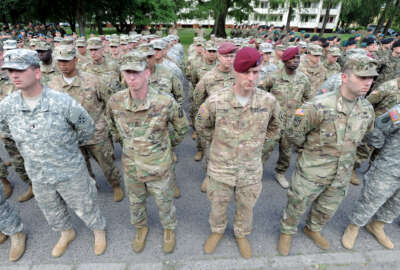 Exclusive
Exclusive  Exclusive
Exclusive The military's top reserve officers told Congress they have too many other issues to prioritize over duty status pay and benefits.
The military’s top reserve officials aren’t too worried about changing the complex system used to calculate pay and benefits for reservists, even going so far as to say it’s not a real problem.
Despite a push from the Office of the Secretary of Defense, educating and simplifying the reserve duty status system is low on the priority list for the heads of the Army and Marine Corps Reserve.
“This is not a pressing concern for me. … This is not a pressing concern for America’s Army Reserve,” said Army Reserve Chief Charles Luckey said during a May 24 House Appropriations Defense Subcommittee hearing. “I don’t think there is a compensation issue or a credit issue as it pertains to retirement. … It is a challenge for reserve soldiers to balance all the requirements of their lives, but the reality is I have fantastic soldiers.”
Marine Corps Forces Reserve Commander Lt. Gen. Rex McMillan echoed Luckey’s statement.
“I’m bookended by readiness, I have 38 training days to train our Marines,” McMillan said. “I need to take full advantage with online training and getting the pay and the benefits [training] between drills, between those 28 days that I don’t have them during the month to bring them up to speed educationally.”
Some within the force and experts in the field feel the issue is much larger, however.
For years reservists received differing pay and benefits depending on which of the 32 duty statuses their orders fell under, causing a bureaucratic mess and gaps in benefits.
“The current [reserve] status system is complex, aligns poorly to current training and mission support requirements, fosters inconsistencies in compensation and complicates rather than supports effective budgeting. Additionally, the [reserve] status system causes members to experience disruptions in pay and benefits as they transition among different duty statuses,” stated a 2015 Military Compensation and Retirement Modernization Commission (MCRMC) report.
One of the most used examples to describe this problem is when an aircraft or helicopter goes down with active duty service members and reservists with different orders on board. Despite doing the same activity, “the benefits are completely different for the surviving spouses,” then-Assistant Secretary of Defense for Manpower and Reserve Affairs Todd Weiler told Federal News Radio in January.
Rep. Tim Ryan (D-Ohio), a member of the House Appropriations Defense Subcommittee, said the reserve leaders’ indifference to the issue is part of a larger problem.
“It gets to sequestration, it gets to the Budget Control Act, it gets to the inability for us to make investments in the kind of things we need to make investments in. It seems like every hearing we discover one other inefficiency or inadequate investment that we are making that’s affecting the quality of life of the troops one way or another and this is a perfect example of that,” Ryan said.
The Defense Department unveiled a plan early this year to consolidate the duty statuses and make it easier for reservists to be compensated.
“By bringing the number of statuses down to a manageable number that’s associated with different duties we can then equalize the benefits across those duties,” Weiler said. “For example, survivor benefits would be the exact same across a certain duty area, or benefits regarding retirement would be exactly the same across a certain duty area and not specifically tied to the statutory authority or the way in which we activated someone.”
Right now, the way reservists are called up differs on a number of factors. Each time the purpose changes — say from aid to state government to training — the original orders must be canceled and new ones are drawn up.
“The status under which [a reserve] member serves differs depending on a variety of factors: whether the status is active duty, full-time National Guard duty, or inactive duty; whether the duty is voluntary or involuntary; and whether the [reserve] member’s mission is training, support or operations. One-hundred seventy statuses may differ based on the type of appropriation that funds the status,” the MCRMC report stated.
The new categories bunch together a handful of each of the previous statuses. For example, category four brings together active services in which a service member might become involved in military actions, provide federal assistance during a disaster, support or training before deployment and post-deployment activities.
DoD is still working on implemented the new statuses, which will most likely need congressional support.
Copyright © 2025 Federal News Network. All rights reserved. This website is not intended for users located within the European Economic Area.
Scott Maucione is a defense reporter for Federal News Network and reports on human capital, workforce and the Defense Department at-large.
Follow @smaucioneWFED
 Exclusive
Exclusive 